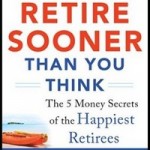
Now that half a year has passed since my Findependence Day arrived in May, I’ve gotten more clarity about certain misconceptions some may have about the concept of Findependence (aka Financial Independence).
I may even have harboured some of these myself at one point in my full-time career. Here are five myths I’ve become aware of: this is not necessarily a definitive list and may be revisited in the future.
Myth 1: After you’re findependent, you’ll play golf all day, or bridge, or read, or travel.
I doubt this will happen for many unless you really burned out in your career. Depending on the degree of your findependence (see the MoneySense Findependence archives for more on this) and how much work you wish to do, you’ll soon settle into a routine. Most of your tasks may be self imposed, but impose them you will! Between 2004 and 2011 or so, while still working full time at the Financial Post, I devoted many nights and weekends playing to online bridge. Oddly, now that I have more time, I no longer play online bridge, although I do make a point of religiously reading Paul Thurston’s bridge column every day on the “Diversions” page of the National Post. Even with no time lost in a downtown office and getting to and from it, I still don’t have time for online bridge. I may resume once I’m “fully retired” later in my 60s but I can’t seem to find the time for it in semi-retirement!
Myth 2: There’s no distinction between weeks and weekends.
For me, at least, the week and weekend routine still operates at most levels. If you’re familiar with my concept of the 4-hour day (normally practiced from Monday to Friday), then on weekends I do not feel obligated to put in either a four-hour or even just one two-hour stint on money-making or creative activities. Of course, you could redirect at least two hours per weekend from money making to creative fun long term projects you’ve always wanted to accomplish. Because at the end of the weekend, once the workweek resumes for everyone else, longer term projects tend to get crowded out by more imminent matters and deadlines.
That said, it’s also true that – at least if you work from home – you tend to attend to some errands like shopping in the workweek lunch hour, if only as a break and a way to get out of the house. So instead of a large weekend grocery shop, I tend to run two or three times a week on specific shopping missions, but add in a few items I know we’ll need soon. The grocery bills tend to be lower on any given shop but of course you’ll have plenty more of them.
Myth 3: Findependence is an all-or-nothing proposition involving a certain “Big Number.”
Ah, big numbers. Lee Eisenberg wrote a bestseller on that called The Number. If your initial Number was $X million or $Y100 thousand, you may find you continue to push even once it’s achieved. It may become 2X or 3Y. The moment you can declare findependence may be a moving target, depending on financial markets, employers, health and many other considerations. You need to be flexible.
Myth 4: The government won’t be there for me (or employer pensions).
 I think whether in U.S. or Canada that the boomer generation can count on the promised social programs and probably the same will hold for succeeding generations. Benefits may not be as generous, may not be inflation hedged, may become means-tested and so on. And yes, these days, it’s hard to count on any one employer pension plan, be it Defined Benefit or newer hybrids that expose workers to some market risk. The whole point of findependence is to establish multiple income streams, which may include part-time earned income or consulting work. That’s a major point Wes Moss makes in his excellent book: You Can Retire Sooner Than You Think.
I think whether in U.S. or Canada that the boomer generation can count on the promised social programs and probably the same will hold for succeeding generations. Benefits may not be as generous, may not be inflation hedged, may become means-tested and so on. And yes, these days, it’s hard to count on any one employer pension plan, be it Defined Benefit or newer hybrids that expose workers to some market risk. The whole point of findependence is to establish multiple income streams, which may include part-time earned income or consulting work. That’s a major point Wes Moss makes in his excellent book: You Can Retire Sooner Than You Think.
Government pensions is one basket and an employer pension is a second one but you know what they say about putting all your eggs into any one of them. If I were counting 100% on Social Security (or OAS/CPP in Canada) then I’d be apprehensive about this. And Moss finds the unhappiest retirees are those who can count on only a single source of income.
But as a single potential flow of income that might account for 20 to 60% of the total, the more you have alternatives, the better. RRSPs/IRAs and other savings are one other vehicle, as are taxable accounts and TFSAs/Roth IRAs. But there are also book or music royalties, real estate investment properties, part-time work and finally the subject we wrote about here last week: Internet marketing and entrepreneurship. The Internet has so much potential for creating multiple streams of findependence income that I almost envy the young people now who would far rather become laptop millionaires than salaried employees
.
Myth 5: The act of declaring Findependence is irrevocable.
If you’ve left a job or sold a business, you may think the act of declaring your Findependence is irrevocable. It’s not. The truth is you can rejoin the workforce if you wish, though most of the “findependent” people I know who got there before me show not the slightest inclination for returning to another stint on the 9-to-5 treadmill. Lately, I’ve been listening to a Valdy song, Coming Home, which contains the lyric, “I’m going back to places that I couldn’t wait to leave.” When the odd notion comes into my head that it might be fun being full time again in magazines or newspapers, that lyric can’t help but run through my mental iPod.
So those are 5 myths. I’ll revisit this list periodically and probably add to them. Reader input always welcome. Email me at jonathan@findependenceday

